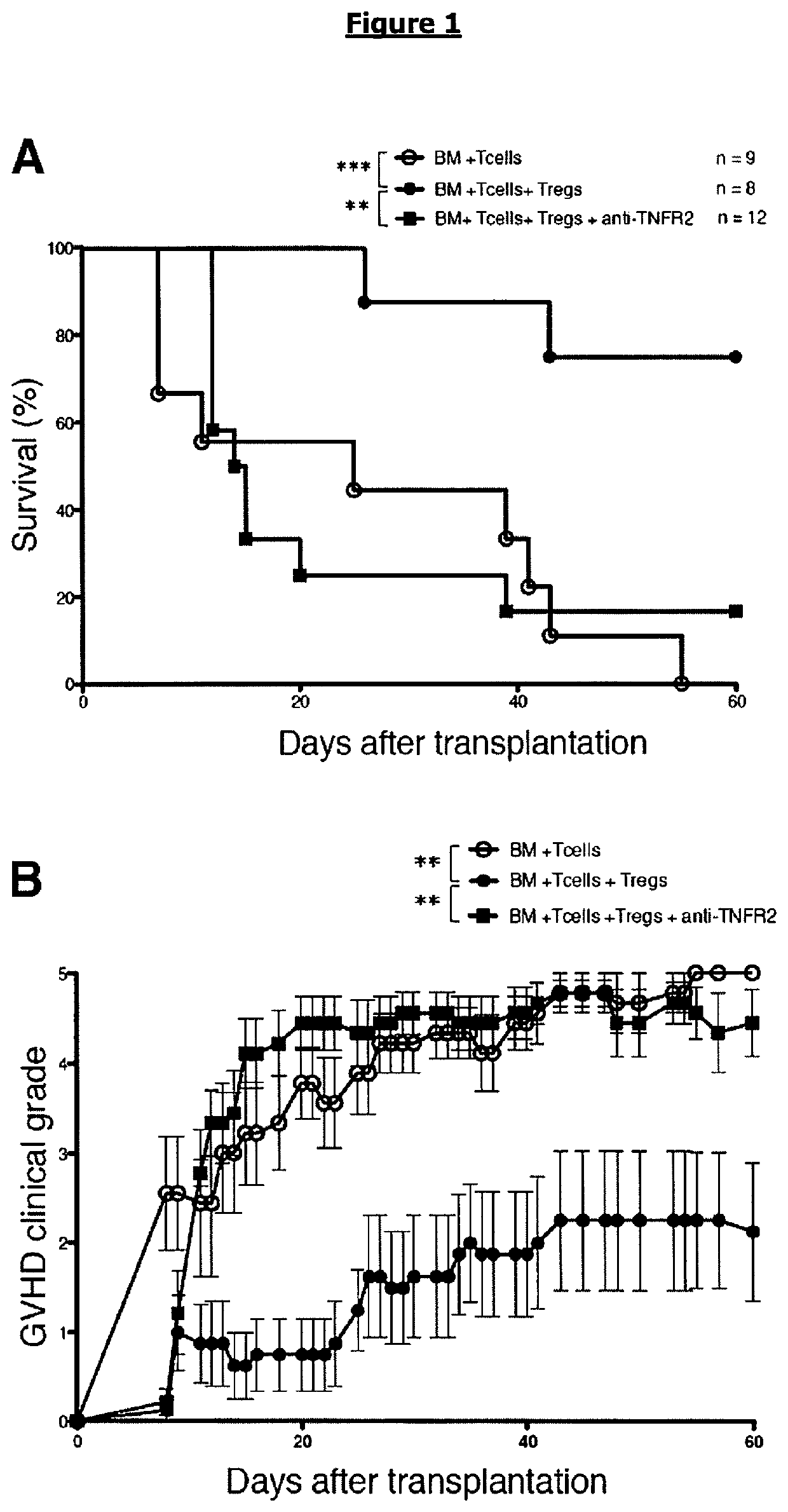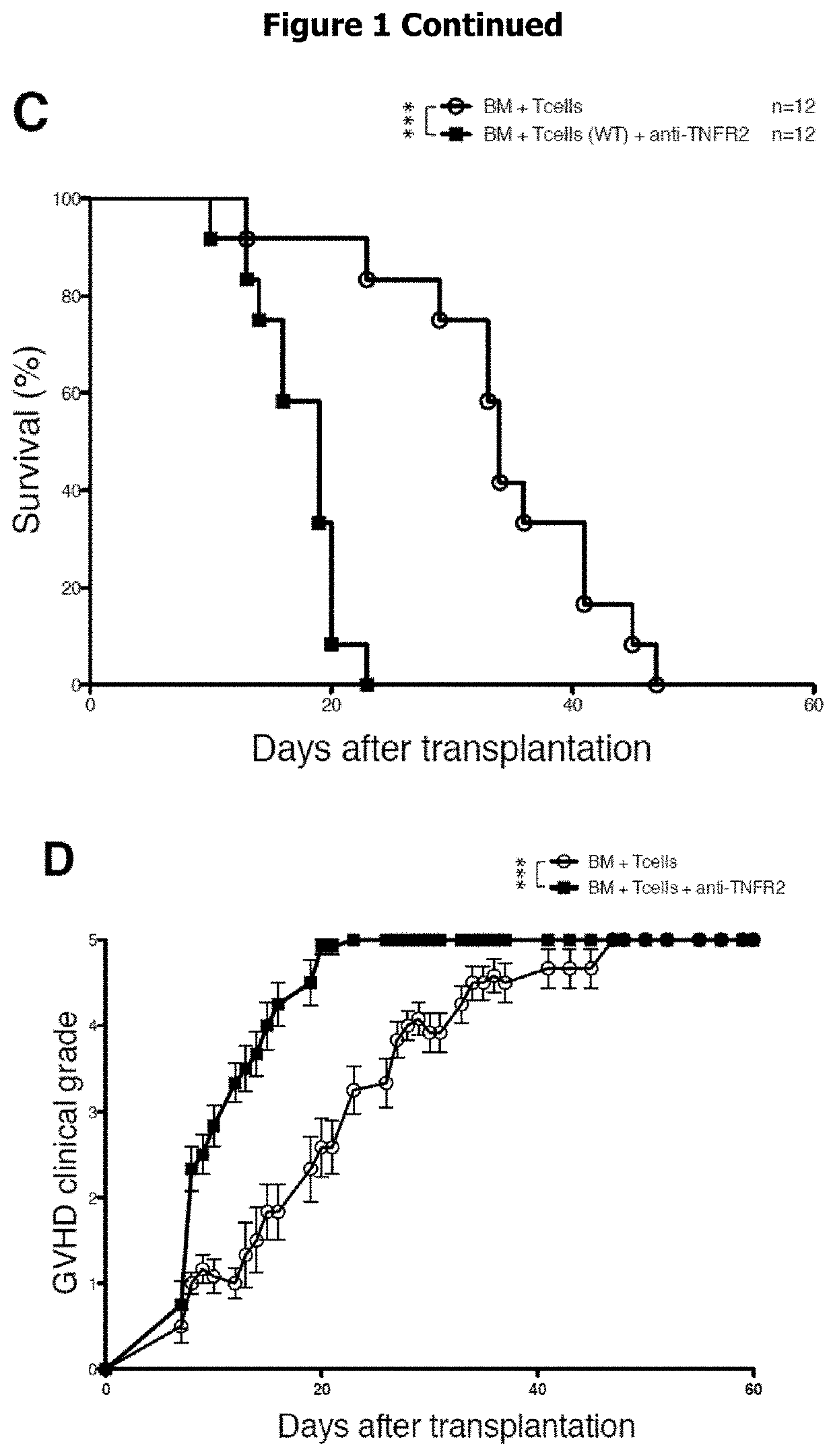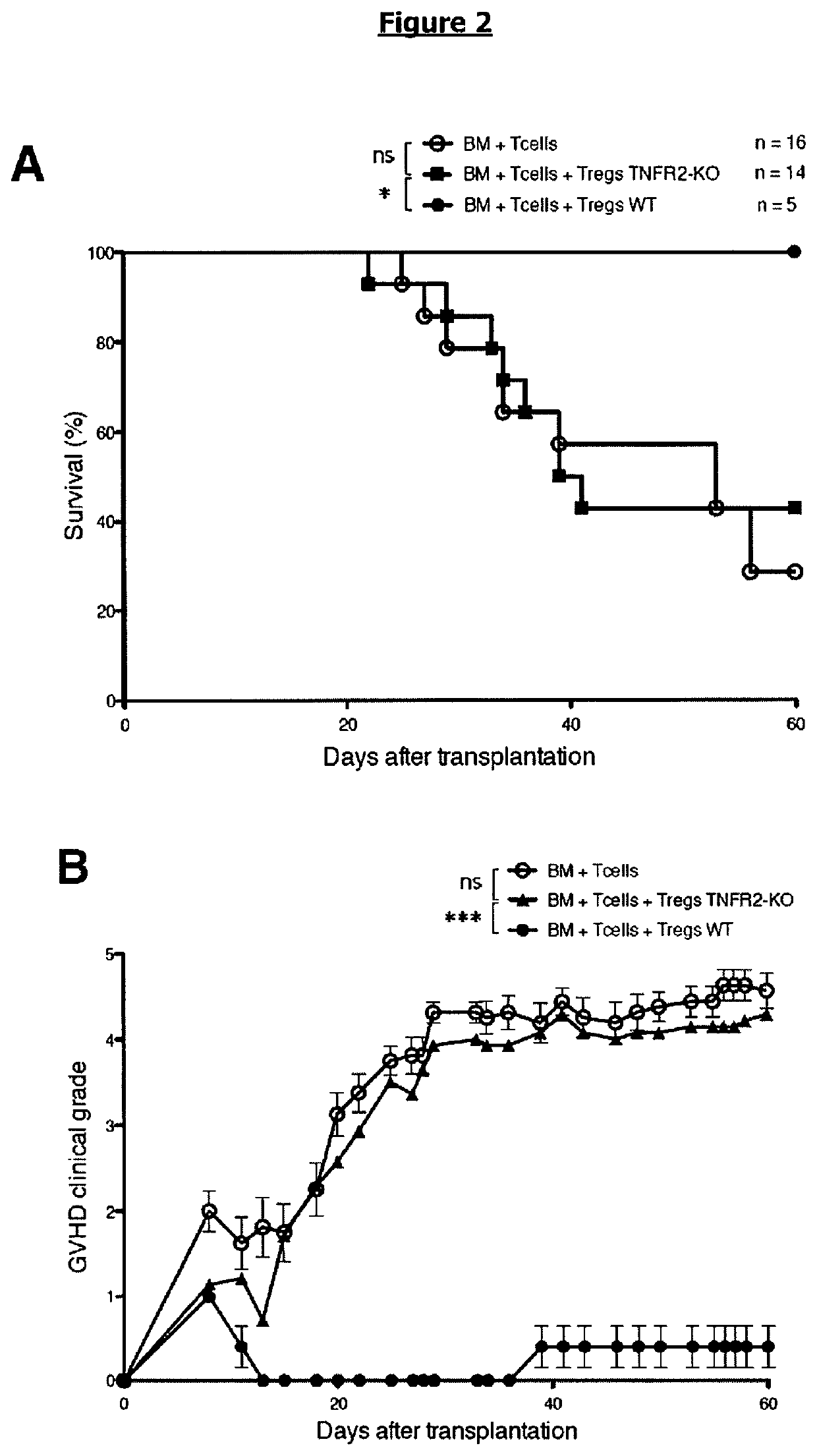Prevention or treatment of hematologic malignancy relapse using a TNFR2 antagonist
a technology of hematologic malignancy and tnfr2 is applied in the field of prevention or treatment of hematologic malignancy relapse using tnfr2 antagonists, which can solve the problems of only partially effective treatment, increased risk of hematologic malignancy relapse, and alloreactive effect of life-threatening graft-versus-host disease (gvhd), and achieves the effect of enhancing the graft versus leuk
- Summary
- Abstract
- Description
- Claims
- Application Information
AI Technical Summary
Benefits of technology
Problems solved by technology
Method used
Image
Examples
example 1
TNFR2 Plays a Pivotal Role in Treg-Mediated Prevention of GVHD and Anti-TNFR2 Antagonist Enhancement of GVL
[0093]To assess the role of TNF on GVHD and GVL by Treg administration, we first used our recently described model in which the disease was prevented by transfer in females recipients of donor Tregs specific for the exogenous (i.e non-donor, non-recipient) HY antigen at time of AHCT, followed by their in vivo re-activation by HY peptide immunization (Martin G H, Gregoire S, Landau D A, et al. In vivo activation of transferred regulatory T cells specific for third-party exogenous antigen controls GVH disease in mice. Eur J Immunol. 2013;43(9):2263-2272). In a semi-allogeneic condition C57BL / 6>[B6×C3H]F1 of bone marrow transplantation, GVHD protection at 1 / 1 Treg / Tconv ratio strictly depends on HY immunization.
[0094]We evaluated the role of TNFR2 in Treg-mediated GVHD and GVL using a anti-TNFR2 antagonist mAb (hereafter “blocking anti-TNFR2 mAb”) (FIGS. 1A and B). Mice transferre...
example 2
After AHCT, TNF / TNFR2 Blockade Reduces Foxp3 and Activation Markers Expression on Tregs
[0099]To analyze by what mechanism the control of GVHD by Tregs and enhancement of the GVL activity depends on TNF / TNFR2 interaction, we measured the proportion and activation markers of Tregs in the spleen collected at day 13 in mice grafted with HY-Tregs and either WT Tcells and treated with blocking anti-TNFR2 mAb or TNF-deficient Tcells. First, the expression level of Foxp3 was significantly reduced when TNF / TNFR2 interaction was inhibited in both settings, whereas Treg proportions remained unchanged (FIG. 7 A, B). This lower Foxp3 expression among whole Tregs was characterized by a reduced proportion of Foxp3high expressing cells and an increased proportion of Foxp3int expressing cells in both experimental models (FIG. 6). A likely explanation would be that, in the absence of TNFR2 signaling in Tregs, Foxp3 would be down-modulated, suggesting that TNF stabilized Foxp3 expression in Tregs. In ...
example 3
Improved Anti-Tumor Effect of T Cells by Anti-TNFR2 Treatment
[0103]Eight to 12-week-old recipient B6D2F1 female mice received a 10 Gy irradiation followed by retro-orbital infusion of 5×106 bone marrow (BM) cells+2×104 host type P815 (DBA / 2-derived, H-2Dd, GFP) tumor cells, with (Tumour+T cells group; n=8) or without (Tumor group n=7) 1×106 T cells. BM and T cells were isolated from female C57BL / 6 mice. Tumor (Tumor+TNFR2 group; n=11) and Tumor+Tcells group (Tumor+Tcells+·TNFR2 group; n=11) were treated with 3 intraperitoneal injections of 500 μg of the anti-TNFR2 blocking mAb (TR75-54.7) on days 0, 2, and 4.
[0104]The results are shown in FIG. 8: (FIG. 8A) P815 characterization in blood sample of grafted animals at day 12. Tumoral (FIG. 8B) and GVHD (FIG. 8C) incidence in alloSCT grafted mice.
[0105]Results: 12 days after bone marrow transplantation, p815 cells were detected in blood of grafted mice (FIG. 8A). When mice were transplanted with T cells then treated with the blocking an...
PUM
| Property | Measurement | Unit |
|---|---|---|
| body weight | aaaaa | aaaaa |
| time | aaaaa | aaaaa |
| surface plasmon resonance | aaaaa | aaaaa |
Abstract
Description
Claims
Application Information
 Login to View More
Login to View More - R&D
- Intellectual Property
- Life Sciences
- Materials
- Tech Scout
- Unparalleled Data Quality
- Higher Quality Content
- 60% Fewer Hallucinations
Browse by: Latest US Patents, China's latest patents, Technical Efficacy Thesaurus, Application Domain, Technology Topic, Popular Technical Reports.
© 2025 PatSnap. All rights reserved.Legal|Privacy policy|Modern Slavery Act Transparency Statement|Sitemap|About US| Contact US: help@patsnap.com



